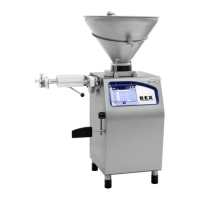
Do you have a question about the REX RVF 327 and is the answer not in the manual?
| Brand | REX |
|---|---|
| Model | RVF 327 |
| Category | Industrial Equipment |
| Language | English |
Provides essential information for personnel operating the vacuum filling machine and emphasizes the need for the manual's availability.
Outlines the copyright ownership of the provided documents and the restricted rights for usage.
Explains the meaning of various symbols used throughout the manual for safety and operational guidance.
Details essential safety guidelines, including warnings, proper usage, and organizational measures for safe operation.
Defines the operational work area and identifies danger zones around the machine for personnel safety.
Provides a brief overview of the machine's capabilities and intended use for various food products.
Specifies the intended applications for the vacuum filling machine, including permitted and restricted product types.
Illustrates the process flow for alternating between different operational modes, including cleaning steps.
Presents a photographic view of the vacuum filling machine for visual identification.
Details the machine's protective devices and their corresponding safety functions for operator protection.
Provides crucial safety information related to control loops, components, and safety evaluation units.
Instructions for transporting the machine, including handling precautions and proper lifting methods.
Guidelines for storing the machine temporarily, ensuring a dry, ventilated, and dust-free environment.
Details the process of setting up the machine, including placement, leveling, and required environmental conditions.
Information on the electrical unit's securing and fuse protection, which must be installed near the machine.
Instructions for horizontally aligning the machine using the adjustable leveling feet.
Specifies the required clearance around the machine for accessible operation, cleaning, and maintenance.
Presents the technical specifications, dimensions, and weight of the vacuum filling machine models.
Guides through the initial steps for starting the machine, including electrical connections and safety checks.
Outlines crucial safety measures, including risks from filling material and guidelines for personnel.
Emphasizes never operating the machine without ruling out all potential dangers and conducting daily inspections.
Explains the function of key control elements, including the touch-screen, ON/OFF keys, and knee lever.
Provides a detailed breakdown of the touch screen interface, explaining each numbered element and its function.
Details the touch-screen controls, including handling suggestions, general properties, and operating modes.
Explains the function of various keys on the machine's keyboard interface, such as rate, weight, and pauses.
Guides users through the steps to install and configure a straight filling program on the machine.
Details how to adjust and set up a portioning program, including various parameters like speed and weight.
Provides instructions for adjusting the twisting off program, covering parameters like speed and portioning.
Explains how to adjust the pressure sensor operation, including setting desired pressure and vacuum levels.
Describes how to adjust controls for a secondary machine, including start/stop advance and beginning portions.
Introduces various special functions available through the Information mask, such as service and recipe management.
Guides users on how to adjust setup parameters, including language, time, and date settings.
Explains how to customize screen settings, including operating modes, display options, and brightness.
Details how to manage recipes, including displaying, sorting, deleting, and renaming filling programs.
Information on user login procedures for different access levels, including administrator and dealer access.
Describes how to access and view the machine's service plan and maintenance schedules.
Explains how to access and adjust settings for the integrated metal detector.
Details the connection and use of the weighing system for portion weight checks and automatic correction.
Explains how alarms and malfunction reports are displayed and managed on the machine's interface.
Provides guidance on how to troubleshoot and repair machine defects, including accessing help for specific alarms.
Step-by-step instructions for attaching the twisting gear, filling tube, and intestine holding device.
Outlines the steps for starting production, including safety warnings and filling the hopper.
Details safety precautions and procedures for cleaning the machine and its components.
Provides comprehensive guidelines on cleaning the machine after production, including material types and procedures.
Outlines safety regulations and procedures for all maintenance, inspection, and reconditioning work.
Details daily, weekly, and 6-month maintenance tasks, including checks on safety switches and greasing fittings.
Offers tips and instructions for greasing various parts of the machine, specifying grease types and quantities.
Provides a checklist of safety precautions and general guidelines to be observed during maintenance and inspection.
Instructions on how to properly shut down the machine and dispose of used oils and components.
A form for documenting the handover of the machine, including customer and installer details.
Declares the machine's compliance with relevant EU directives and standards for safety and operation.
A section for general notes or additional information not covered elsewhere in the manual.
